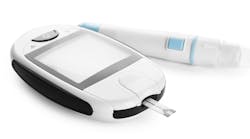The adage "You are what you eat" emphasizes the pivotal role diet plays in human health, particularly gut health in disease prevention and management. People’s dietary choices can either strengthen or compromise their metabolic well-being. With our fast-paced lifestyles, maintaining a healthy diet can present formidable challenges.
The consequences of processed foods, sedentary lifestyles, carbohydrate-rich diets, and inadequate sleep patterns manifest in the increasing prevalence of insulin resistance. Here I’ll explain the statistics surrounding metabolic disorders, explore strategies for mitigating insulin spikes, and evaluate the efficacy of in-office therapeutic modalities in making patient outcomes better.
The statistics
More than 11% of Americans—38.4 million people—have diabetes. An alarming 96.7 million people ages 18 and over are prediabetic. One in three adults are prediabetic without even knowing it.1 Prediabetes is caused by insulin resistance, which occurs when cells cannot easily absorb glucose from the blood.
This process of insulin resistance can start as many as 20 years before the diagnosis, leaving an individual's metabolic processes out of sync.2 Insulin resistance is a root cause of cancer, heart disease, Alzheimer’s disease, cardiovascular disease, weight gain, fatty liver, dementia, low testosterone, menstrual irregularities, infertility, and more.3 The signs and symptoms of insulin resistance often go unnoticed.
Common symptoms of insulin resistance
Many people don’t equate the subtle symptoms of insulin resistance to anything out of the ordinary. Symptoms may include feeling tired after eating meals, increased thirst, frequent urination, increased hunger, blurred vision, headaches, skin infections, slow-healing cuts and sores, itchy skin, tingling in the hands or feet, feeling more tired than usual, acne or skin tags, low estrogen in women, low testosterone in men, high blood pressure, craving sweets after meals, and eating sweets that do not fulfill the craving.4
Individuals with blood pressure readings of 130/80 or higher, or a waistline of more than 40 inches in men and 35 inches in women, are at higher risk of insulin resistance.4 Signs that the body is experiencing insulin resistance are energy crashes between 11 am and 3 pm, brain fog, and frequent food cravings.
The sugar addiction
The more sugar we consume, the more we tend to crave. The sweet taste perception is an innate capacity of the T1R2 and T1R3 that are located on the tongue.5 Scientists suspect that this intense sensory pleasure of sweets is driving the obesity epidemic. The passive overconsumption of sugar-sweetened diets has been compared to drug addiction. Lenoir et al. concluded that the intense sweetness surpasses the cocaine reward.5 No wonder people are moody when they try to kick sugar!
Hack your glucose
A Cornell University study showed that eating vegetables and protein before carbohydrates reduces the glucose spike by 73%. Not changing the food we eat, but eating it in the correct order, can have this impact.6 I was introduced to this concept after reading The Glucose Revolution by Jessie Inchauspe. Known as the “Glucose Goddess” on Instagram, Jessie is a French biochemist who’s devoted her scientific work to determining how the pancreas responds to a glucose spike. She believes that no food is good or bad. Instead, she’s found through her work with constant glucose monitors that the order in which we eat our food is most important in the glucose response.
Eat greens first. The fiber slows the gastric emptying and creates a mesh that makes it harder for the glucose to get to the bloodstream.7 Any vegetable works, such as asparagus, broccoli, arugula, lettuce, or tomatoes. A small green salad with vinegar and olive oil can be an easy starter after a long day of work. Proteins and fats come after the fiber, followed by starches and sugar.
Another glucose hack is to not count the calories consumed. Research shows that diets focused on flattening glucose levels result in more fat loss than those focused on reducing calories. Breakfast is an important meal of the day, especially because the food is digested quickly, and the body is more sensitive to glucose. Nondiabetics can experience the same glucose spikes and harmful side effects as diabetics if there’s too much of a glucose spike. Eating a sweet dessert at the end of a meal creates a lower glucose spike than having a sweet snack alone. One final glucose hack is to walk after meals as this helps reduce the glucose burden.7
Proposed practice protocol
The American Dental Association (ADA) has proposed in-office monitoring and documenting patient blood glucose and HbA1c levels.8 The CDT code D0411 has been deemed for HbA1c in-office point-of-service testing, and the CDT code D0412 is a blood glucose level test in the office using a glucose meter.8
Using the D0412 procedure, a dentist can determine how the patient’s blood glucose level may affect treatment. A glucose level below 70 mg/dl is the clinical definition of a hypoglycemia alert level, which means the patient is at risk of a hypoglycemic event during the dental procedure.8 Therefore, treatment should be deferred until the patient’s blood sugar level is in the acceptable range. A glucose level over 300 mg/dl could lead to delayed healing of the surgical site and severe infection.8 This suggests rescheduling elective surgical procedures until the glucose level is in an acceptable range.
By prioritizing vegetable consumption, optimizing meal composition, and incorporating postmeal physical activity, people can mitigate glucose spikes and promote metabolic resilience. In-office monitoring of blood glucose and HbA1c levels can offer tailored treatment to patients and reduce the risks of providing contraindicated procedures. Join me in hacking your glucose spikes to improve your overall health.
Editor's note: This article appeared in the April/May 2024 print edition of RDH magazine. Dental hygienists in North America are eligible for a complimentary print subscription. Sign up here.
References
- National Diabetes Statistics Report. Centers for Disease Control and Prevention. November 29, 2023. www.cdc.gov/diabetes/data/statistics-report/index.html
- Diabetes may begin more than 20 years before diagnosis. ScienceDaily. October 4, 2018. www.sciencedaily.com/releases/2018/10/181004192202.htm
- Bikman B. Why We Get Sick: The Hidden Epidemic at the Root of Most Chronic Disease—and How to Fight It. 2020. BenBella Books.
- Insulin resistance: what it is, causes, symptoms & treatment. Cleveland Clinic. Accessed February 12, 2024. my.clevelandclinic.org/health/diseases/22206-insulin-resistance
- Lenoir M, Serre F, Cantin L, Ahmed SH. Intense sweetness surpasses cocaine reward. PLoS One. 2007;2(8):e698. doi:10.1371/journal.pone.0000698
- Machalinski A. Food order impacts glucose and insulin levels. Cornell Chronicle. June 26, 2015. news.cornell.edu/stories/2015/06/food-order-impacts-glucose-and-insulin-levels
- Inchauspé J. Glucose Revolution: The Life-Changing Power of Balancing Your Blood Sugar. 2023. Simon Element.
- D0411 and D0412 – ADA quick guide to in-office monitoring and documenting patient blood glucose and HbA1C level. February 12, 2024. www.ada.org/-/media/project/ada-organization/ada/ada-org/files/publications/cdt/cdt_d0411_d0412_guide_v1_2019jan02.pdf
Amber Auger, MPH, RDH, is an international lecturer, a 2019 Sunstar/RDH Award of Distinction recipient, editorial director for RDH Graduate, creator of Thrive in the Op, and certified Functional RDH. Amber has more than 18 years of experience in the dental field and has been practicing dental hygiene since 2010. An active mentor to fellow hygienists, she champions personal and professional growth through her innovative Thrive in the Op on-demand courses and live coaching sessions. She can be reached at [email protected].








